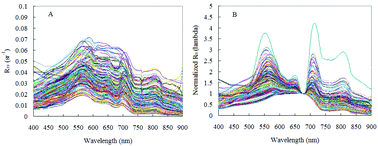Specific inherent optical quantities of complex turbid inland waters, from the perspective of water classification
Abstract
For optically complex turbid productive waters, the optical behavior of suspended particles is the keynote of characterizing the unordered variations of inherent optical properties (IOPs). Multiple bio-optical measurements and sampling of optically active substances were performed in Lake Taihu, Lake Chaohu, and Lake Dianchi, and Three Gorges reservoir of China, in 2008, 2009, and 2010. On the basis of obtaining adequate observation data, we developed an improved and robust water classification approach, by which complex water conditions were divided into three types, i.e., Type 1 (Normalized Trough Depth at 675 nm, hereafter NTD675, ≥0.092), Type 2 (0 < NTD675 < 0.092), and Type 3 (NTD675 ≤ 0). Furthermore, the specific inherent optical quantities for suspended particles, including the specific absorption coefficient of non-algal particles (a*nap), the specific absorption coefficient of phytoplankton (a*ph), and the specific scattering coefficient of the suspended particles (b*p), were determined for the three classified types of waters. The validation results showed that our proposed values for these specific inherent optical quantities presented relatively high predictive accuracies, with most mean absolute percentage errors (MAPE) near 30%, and more importantly, performed much better than that of non-classified waters. Additionally, relative contributions of phytoplankton and non-algal particles to the total particulate absorption and scattering, as well as the spectra, were also analyzed, and the differences among the three classified types of waters were clarified. Overall, the results obtained in this study provide us with new knowledge for understanding complex varied inherent optical properties of highly turbid productive waters.


 Please wait while we load your content...
Please wait while we load your content...